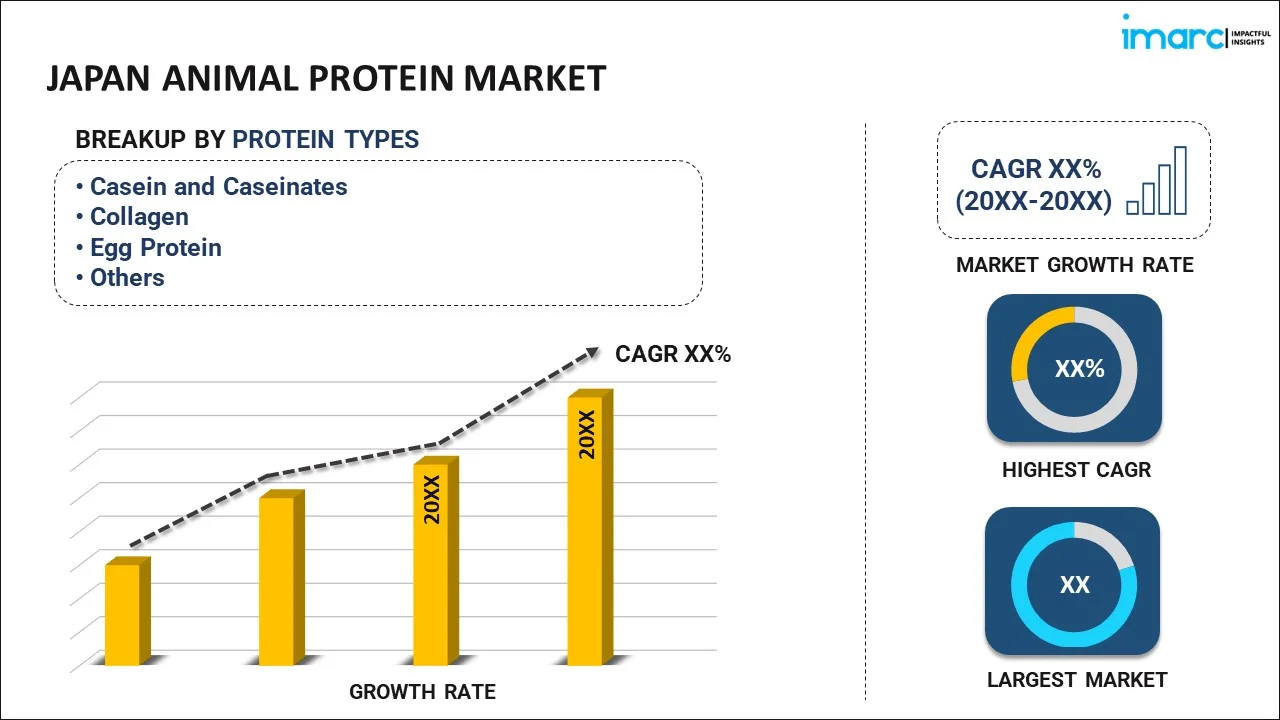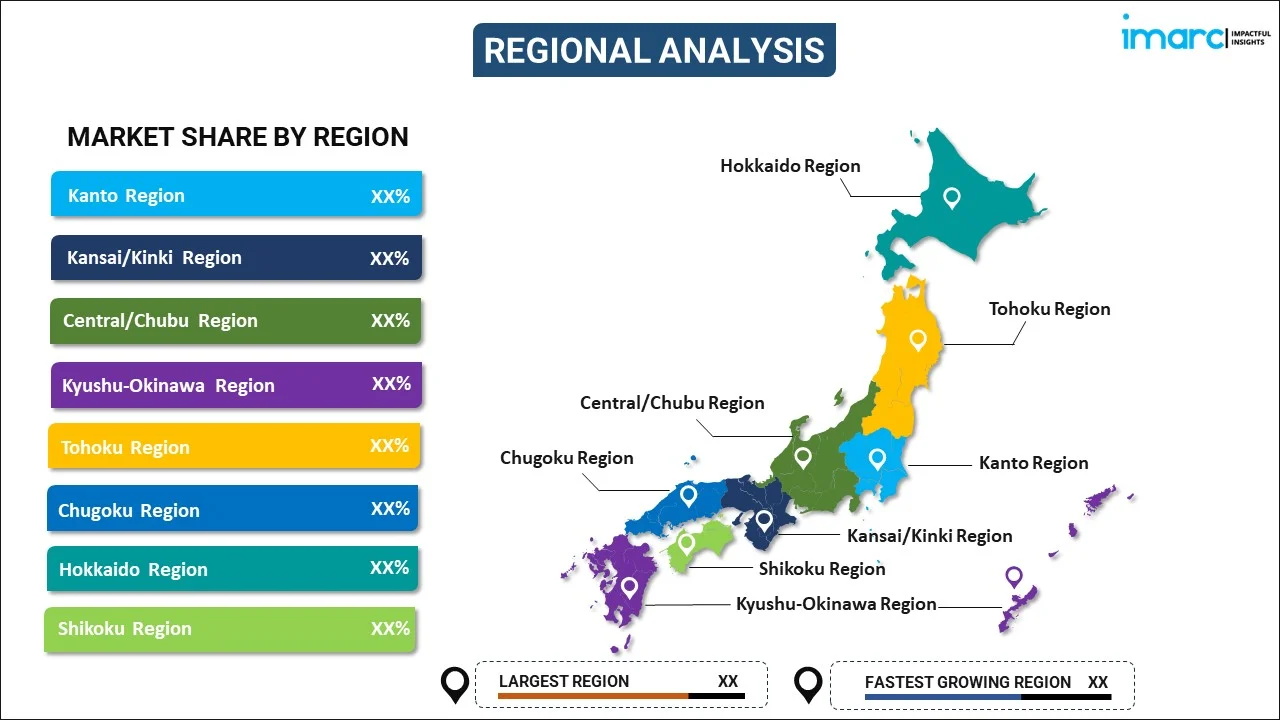
Japan Animal Protein Market Report by Protein Type (Casein and Caseinates, Collagen, Egg Protein, Gelatin, Insect Protein, Milk Protein, Whey Protein, and Others), End User (Animal Feed, Personal Care and Cosmetics, Food and Beverages, Supplements), and Region 2025-2033
Market Overview:
Japan animal protein market size reached USD 1,805.4 Million in 2024. Looking forward, IMARC Group expects the market to reach USD 2,136.7 Million by 2033, exhibiting a growth rate (CAGR) of 1.9% during 2025-2033. The increasing demand for protein-rich diets among individuals, owing to the rising health-consciousness, is primarily augmenting the market growth.
|
Report Attribute
|
Key Statistics
|
|---|---|
|
Base Year
|
2024
|
|
Forecast Years
|
2025-2033
|
|
Historical Years
|
2019-2024
|
|
Market Size in 2024
|
USD 1,805.4 Million |
|
Market Forecast in 2033
|
USD 2,136.7 Million |
| Market Growth Rate 2025-2033 | 1.9% |
Animal protein is derived from the tissues of animals. It is a crucial component of the human diet that helps to provide essential nutrients, vitamins, and minerals vital for optimal body function. Some of the common sources of animal protein include meat, dairy products, eggs, fish, etc., each contributing a unique set of nutritional benefits. They are generally essential for repairing and building muscle, as well as for many other bodily functions. In line with this, animal protein contains all the crucial amino acids that are fundamental building blocks of life, integral to various physiological processes, such as the repairing of tissues, nutrient absorption, supporting the immune system, etc. Consequently, it is considered an important part of a balanced diet.
Japan Animal Protein Market Trends:
The animal protein market in Japan is distinctive, reflecting the region's unique dietary patterns, cultural influences, and culinary preferences. One of the primary factors is the widespread consumption of seafood and meat, particularly pork, beef, and chicken, fueled by the increasing influence of western cuisines. Besides this, stringent food safety regulations and meticulous quality standards implemented by government bodies have spurred innovations and advancements in animal husbandry, processing, and production, ensuring the delivery of high-quality animal protein products to consumers, which is acting as another significant growth-inducing factor. Additionally, Japan imports a substantial amount of animal protein to meet domestic demand, thereby engaging in international trade partnerships to secure stable and diversified sources. Apart from this, the market dynamics are also shaped by consumer awareness and concerns related to health, sustainability, and animal welfare, which, in turn, is driving the exploration and acceptance of alternative protein sources and sustainable production practices. With a blend of tradition and modernity, the animal protein market in Japan will continue to evolve and present a complex tapestry of consumer choices, preferences, and values.
Japan Animal Protein Market Segmentation:
IMARC Group provides an analysis of the key trends in each segment of the market, along with forecasts at the country level for 2025-2033. Our report has categorized the market based on protein type and end user.
Protein Type Insights:

- Casein and Caseinates
- Collagen
- Egg Protein
- Gelatin
- Insect Protein
- Milk Protein
- Whey Protein
- Others
The report has provided a detailed breakup and analysis of the market based on the protein type. This includes casein and caseinates, collagen, egg protein, gelatin, insect protein, milk protein, whey protein, and others.
End User Insights:
- Animal Feed
- Personal Care and Cosmetics
- Food and Beverages
- Bakery
- Beverages
- Breakfast Cereals
- Condiments/Sauces
- Confectionery
- Dairy and Dairy Alternative Products
- RTE/RTC Food Products
- Snacks
- Supplements
- Baby Food and Infant Formula
- Elderly Nutrition and Medical Nutrition
- Sport/Performance Nutrition
A detailed breakup and analysis of the market based on the end user have also been provided in the report. This includes animal feed, personal care and cosmetics, food and beverages (bakery, beverages, breakfast cereals, condiments/sauces, confectionery, dairy and dairy alternative products, RTE/RTC food products, and snacks), and supplements (baby food and infant formula, elderly nutrition and medical nutrition, and sport/performance nutrition).
Regional Insights:

- Kanto Region
- Kansai/Kinki Region
- Central/ Chubu Region
- Kyushu-Okinawa Region
- Tohoku Region
- Chugoku Region
- Hokkaido Region
- Shikoku Region
The report has also provided a comprehensive analysis of all the major regional markets, which include Kanto Region, Kansai/Kinki Region, Central/ Chubu Region, Kyushu-Okinawa Region, Tohoku Region, Chugoku Region, Hokkaido Region, and Shikoku Region.
Competitive Landscape:
The market research report has also provided a comprehensive analysis of the competitive landscape. Competitive analysis such as market structure, key player positioning, top winning strategies, competitive dashboard, and company evaluation quadrant has been covered in the report. Also, detailed profiles of all major companies have been provided.
Japan Animal Protein Market Report Coverage:
| Report Features | Details |
|---|---|
| Base Year of the Analysis | 2024 |
| Historical Period | 2019-2024 |
| Forecast Period | 2025-2033 |
| Units | Million USD |
| Scope of the Report | Exploration of Historical Trends and Market Outlook, Industry Catalysts and Challenges, Segment-Wise Historical and Future Market Assessment:
|
| Protein Types Covered | Casein and Caseinates, Collagen, Egg Protein, Gelatin, Insect Protein, Milk Protein, Whey Protein, Others |
| End Users Covered |
|
| Regions Covered | Kanto Region, Kansai/Kinki Region, Central/ Chubu Region, Kyushu-Okinawa Region, Tohoku Region, Chugoku Region, Hokkaido Region, Shikoku Region |
| Customization Scope | 10% Free Customization |
| Post-Sale Analyst Support | 9-11 Weeks |
| Delivery Format | PDF and Excel through Email (We can also provide the editable version of the report in PPT/Word format on special request) |
Key Questions Answered in This Report:
- How has the Japan animal protein market performed so far and how will it perform in the coming years?
- What has been the impact of COVID-19 on the Japan animal protein market?
- What is the breakup of the Japan animal protein market on the basis of protein type?
- What is the breakup of the Japan animal protein market on the basis of end user?
- What are the various stages in the value chain of the Japan animal protein market?
- What are the key driving factors and challenges in the Japan animal protein?
- What is the structure of the Japan animal protein market and who are the key players?
- What is the degree of competition in the Japan animal protein market?
Key Benefits for Stakeholders:
- IMARC’s industry report offers a comprehensive quantitative analysis of various market segments, historical and current market trends, market forecasts, and dynamics of the Japan animal protein market from 2019-2033.
- The research report provides the latest information on the market drivers, challenges, and opportunities in the Japan animal protein market.
- Porter's five forces analysis assist stakeholders in assessing the impact of new entrants, competitive rivalry, supplier power, buyer power, and the threat of substitution. It helps stakeholders to analyze the level of competition within the Japan animal protein industry and its attractiveness.
- Competitive landscape allows stakeholders to understand their competitive environment and provides an insight into the current positions of key players in the market.
Need more help?
- Speak to our experienced analysts for insights on the current market scenarios.
- Include additional segments and countries to customize the report as per your requirement.
- Gain an unparalleled competitive advantage in your domain by understanding how to utilize the report and positively impacting your operations and revenue.
- For further assistance, please connect with our analysts.
 Inquire Before Buying
Inquire Before Buying
 Speak to an Analyst
Speak to an Analyst
 Request Brochure
Request Brochure
 Request Customization
Request Customization




.webp)




.webp)












